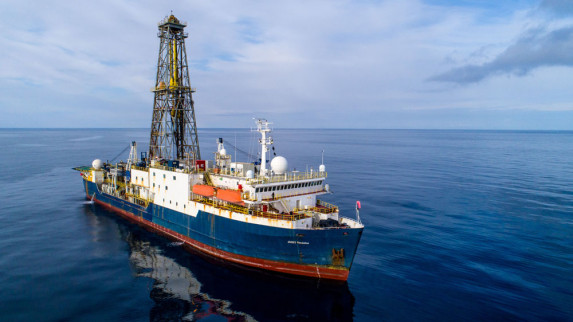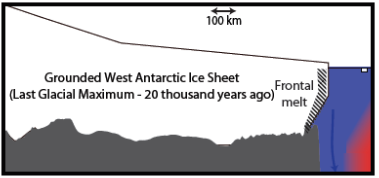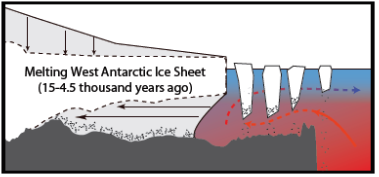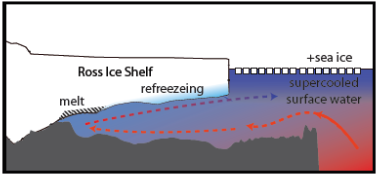Research
Published 10 February 2025Warming seas vs frozen continent: Interactions between ocean and Antarctic ice sheets during past climate changes

Ancient sediments reveal how ice sheets and the ocean “talk to each other” as they respond to, and shape, climate change
Higher ocean and air temperatures due to climate change are attacking the two ice masses that cover Antarctica. The larger and colder East Antarctic Ice Sheet mainly melts from the surface as the air gets warmer. The smaller West Antarctic Ice Sheet is sitting mostly on bedrock below sea level, i.e., it is marine based. This makes it vulnerable to shifting winds that are driving warm currents towards its margin. The warmer water could melt parts of the ice sheet that are floating on seawater from underneath. Once started, this melting could continue downwards along the ice sheet base in a run-away effect. Already, the West Antarctic Ice Sheet and the surrounding ice shelves (floating glacier ice) are losing more and more ice. A complete collapse would raise sea level by several meters. To know how likely this is, we need to understand if the interplay of glacial meltwater and oceanic circulation will dampen or amplify future climate change.
Professor Rob McKay (Te Herenga Waka Victoria University of Wellington), with national and international collaborators, studied ancient ocean sediments to answer this question. The samples they used are geological cores drilled by the International Ocean Discovery Programme (IODP) in Antarctic waters, preserving a unique record of past environment changes.

The IODP drill ship JOIDES Resolution in the Ross Sea, Antarctica. Photo by William Crawford, courtesy of IODP JRSO)
To identify when ice sheets disappear, the team analysed microscopic fossils and tell-tale chemical compounds in the sediment that change with specific environmental conditions. Over the past 45 million years, marine based ice sheets could not persist when surface waters in the Ross Sea exceeded ~1.5–3.4 °C. This happened when atmospheric carbon dioxide levels rose above 400 parts per million (ppm) for extended periods. At more than 500 ppm, even the larger and more stable East Antarctic Ice Sheet started to melt.
The researchers then studied how meltwater changed the ocean in response. They combined climate model experiments with analyses of minute differences in atomic weight measured in chemicals produced by algae, i.e., isotopic signatures in lipid biomarkers. When the ice Age ended, warmer water hit the front of the ice sheet where it is grounded on bedrock. The ocean melted a cavity underneath the huge Ross Ice Shelf. More sea water circulated beneath the shelf, melting it from underneath. However, once the cavity got too big, the waters cooled along their journey underneath the shelf until they froze to its underside. Freezing and melting offset each other. Consequently, a “switch” occurred, and the water that emerged from underneath the shelf was colder than the freezing point of the ocean surface. These supercooled waters triggered enhanced sea ice formation, changed the growth of algae, and cooled the ocean around Antarctica.

Changes to the West Antarctic Ice Sheet and the Ross Ice Shelf since the height of the last ice age shown in cross sections A) At the Last Glacial Maximum, cold waters protected the ice sheet that covered all the bedrock around Antarctica (investigator supplied)

B) When air and surrounding ocean warmed, they caused ice loss (light grey areas) and created a warm ice shelf cavity (investigator supplied)

C) The switch to a cold cavity occurs as warm water enters, cools as it melts ice, partly freezes to the ice shelf base, and emerges as supercooled water (investigator supplied)
This means that under certain conditions, warming can create processes that dampen further warming. However, under future climate change, the cold Ross Ice Shelf cavity could rapidly switch back to a warm cavity. In a chain reaction, the large ice shelves would collapse, sea ice formation would dwindle, and the marine based ice sheet retreat rapidly.
These results are notable because human activities have now increased carbon dioxide beyond 400 ppm, the threshold where past ice sheets and shelves collapsed. They can be used to train models that simulate climate, ice sheets, and the ocean to “talk to each other” and determine necessary cuts to greenhouse gas emissions and coastal flood protection.
Additional information: Link to paper in Nature Geoscience
Additional information: Link to paper in Climate of the Past
RESEARCHER
Professor Rob McKay
ORGANISATION
Te Herenga Waka Victoria University of Wellington
FUNDING SUPPORT
Marsden Fund
CONTRACT OR PROJECT ID
VUW1808
